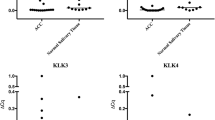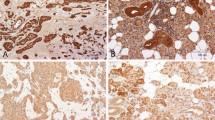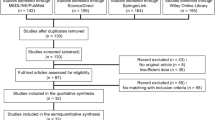Abstract
Polymorphous adenocarcinoma (PAC) is the second most common malignant salivary gland tumour of minor salivary glands. Human tissue kallikreins (KLKs) are a family of highly conserved serine proteases expressed by various tissues and organs. The literature demonstrates a link between KLKs and salivary gland neoplasms. The purpose of this study was to determine levels of KLK mRNA in tissue samples of PAC and to determine if KLK expression is limited to tumour cells. Nineteen cases of PAC were reviewed (1987–2013). The diagnosis was confirmed, demographic data was collected, and formalin fixed paraffin-embedded PAC and normal salivary gland tissue samples were obtained. RNA isolation was achieved, followed by conversion to complementary DNA via reverse transcription. Using PCR, the quantitative level of expression of KLKs1–15 was recorded. Samples exhibiting high and low KLK expression were selected for immunohistochemistry staining. Results revealed a statistically significant increase in mean KLK mRNA expression for KLK1, KLK4, KLK10, KLK12 and KLK15 in PAC tissue samples, compared with normal salivary gland tissue (Mann–Whitney U test, p < 0.05). Immunohistochemistry results demonstrated that KLKs were present in tumor cells. Notably, all samples demonstrating relatively higher KLK mRNA expression showed equivalent or increased staining scores relative to the low KLK mRNA expression samples. In conclusion, there appears to be aberrant kallikrein expression in polymorphous adenocarcinoma, suggesting the possibility of a kallikrein cascade influence on tumor development and progression.



Similar content being viewed by others
References
Neville BW, Damm DD, Allen CM, Chi AC. Oral and maxillofacial pathology. 4th ed. St. Louis: Elsevier; 2016. p. 422–72.
Fonseca I, Assaad A, Katabi N, Seethala R, Weinreb I, Wenig BM. Polymorphous adenocarcinoma. In: El-Naggar AK, Chan JKC, Grandis JR, Takashi T, Slootweg PJ, editors. WHO classification of head and neck tumours. 4th ed. Lyon: International Agency for Research on Cancer; 2017. p. 167–8.
Chi AC, Neville BW. Surface papillary epithelial hyperplasia (rough mucosa) is a helpful clue for identification of polymorphous low-grade adenocarcinoma. Head Neck Pathol. 2015;9:244–52.
Rooper L, Sharma R, Bishop JA. Polymorphous low grade adenocarcinoma has a consistent p63+/p40− immunophenotype that helps distinguish it from adenoid cystic carcinoma and cellular pleomorphic adenoma. Head Neck Pathol. 2015;9:79–84.
Persson F, Fehr A, Sundelin K, Schulte B, Lon̈ing T, Stenman G. Studies of genomic imbalances and the MYB-NFIB gene fusion in polymorphous low-grade adenocarcinoma of the head and neck. Int J Oncol. 2012;40:80–4.
Weinreb I, Zhang L, Tirunagari LMS, Sung YS, Chen CL, Perez-Ordonez B, et al. Novel PRKD gene rearrangements and variant fusions in cribriform adenocarcinoma of salivary gland origin. Genes Chromosome Cancer. 2014;53:845–56.
Strimbu K, Tavel JA. What are biomarkers? Curr Opin HIV AIDS. 2010;5(6):463–6.
Kontos CK, Scorilas A. Kallikrein-related peptidases (KLKs): a gene family novel cancer biomarkers. Clin Chem Lab Med. 2012;50:1877–91.
Obiezu CV, Diamandis EP. Human tissue kallikrein gene family: applications in cancer. Cancer Lett. 2005;224(1):1–22.
Pavlopoulou A, Pampalakis G, Michalopoulos I, Sotiropoulou G. Evolutionary history of tissue kallikreins. PLoS ONE. 2010;5(11):e13781.
Sotiropoulou G, Pampalakis G, Diamandis EP. Functional roles of human Kallikrein-related peptidases. J Biol Chem. 2009;284(48):32989–94.
Yousef GM, Scorilas A, Katsaros D, Fracchioli S, Iskander L, Borgono C, et al. Prognostic value of the human kallikrein gene 15 expression in ovarian cancer. J Clin Oncol. 2003;21:3119–266.
Borgoño CA, Grass L, Soosaipillai A, Yousef GM, Petraki CD, Howarth DHC, et al. Human kallikrein 14: a new potential biomarker for ovarian and breast cancer. Cancer Res. 2003;63:9032–41.
Yousef GM, Polymeris M-E, Grass L, Soosaipillai A, Chan P-C, Scorilas A, et al. Human kallikrein 5: a potential novel serum biomarker for breast and ovarian cancer. Cancer Res. 2003;63:3958–65.
Yousef GM, Diamandis EP. Kallikreins, steroid hormones and ovarian cancer: is there a link? Minerva Endocrinol. 2002;27:157–66.
Emami N, Diamandis EP. Utility of kallikrein-related peptidases (KLKs) as cancer biomarkers. Clin Chem. 2008;54:1600–7.
Yousef GM, Diamandis EP. Expanded human tissue kallikrein family—a novel panel of cancer biomarkers. Tumour Biol. 2002;23:185–92.
Emami N, Diamandis EP. Potential role of multiple members of the kallikrein-related peptidase family of serine proteases in activating latent TGF beta 1 in semen. Biol Chem. 2010;391:85–95.
Darling MR, Jackson-Boeters L, Daley TD, Diamandis EP. Human kallikrein 13 expression in salivary gland tumors. Int J Biol Markers. 2006;21:106–10.
Darling MR, Tsai S, Jackson-Boeters L, Daley TD, Diamandis EP. Human kallikrein 8 expression in salivary gland tumors. Head Neck Pathol. 2008;2(3):169–74.
Darling MR, Hashem NN, Zhang I, Mohamed ABD, Fung K, Kwan K, et al. Kallikrein-related peptidase 10 expression in salivary gland tissues and tumours. Int J Biol Markers. 2012;27:e381–e388388.
Hashem NN, Mara TW, Mohamed M, Zhang I, Fung K, Kwan KF, et al. Human kallikrein 14 (KLK14) expression in salivary gland tumors. Int J Biol Markers. 2010;25:32–7.
Kerr Z, Hayter A, Khan Z, Darling M. Kallikrein-related peptidase mRNA expression in adenoid cystic carcinoma of salivary glands: a polymerase chain reaction study. Head Neck Pathol. 2019. https://link.springer.com/10.1007/s12105-019-01076-4 (Epub ahead of print).
Morrison MD, Jackson-Boeters L, Khan ZA, Shimizu MS, Franklin JH, Fung K, et al. Identifying candidate biomarkers for pleomorphic adenoma: a case–control study. Head Neck Pathol. 2019;13:286–97.
Hashem N, Mohamed M, Zhang I, Fung K, Kwan K, Mara T, et al. Kallikrein-related peptidase 7 in salivary gland tumours: immunohistochemical profile. Can J Pathol. 2011;3:12–9.
Funding
Dr. M. Darling was supported by Internal Research Grant, University of Western Ontario.
Author information
Authors and Affiliations
Corresponding author
Ethics declarations
Conflict of interest
The authors have no conflict of interest to declare.
Ethical Approval
Research involved formalin fixed paraffin embedded tissues only. This study was approved by the Western University Research and Ethics Board, Project ID 103783. The study was performed in accordance with the ethical standards as laid down in the 1964 Declaration of Helsinki.
Additional information
Publisher's Note
Springer Nature remains neutral with regard to jurisdictional claims in published maps and institutional affiliations.
Rights and permissions
About this article
Cite this article
Cox, J., Khan, Z., Jackson-Boeters, L. et al. Human Tissue Kallikreins in Polymorphous Adenocarcinoma: A Polymerase Chain Reaction and Immunohistochemical Study. Head and Neck Pathol 15, 169–178 (2021). https://doi.org/10.1007/s12105-020-01196-2
Received:
Accepted:
Published:
Issue Date:
DOI: https://doi.org/10.1007/s12105-020-01196-2




